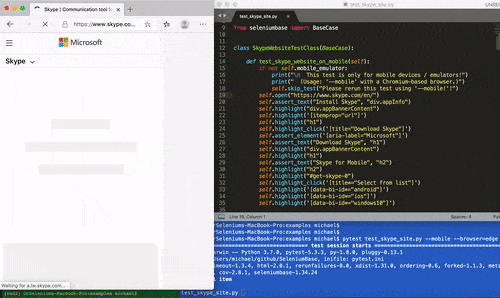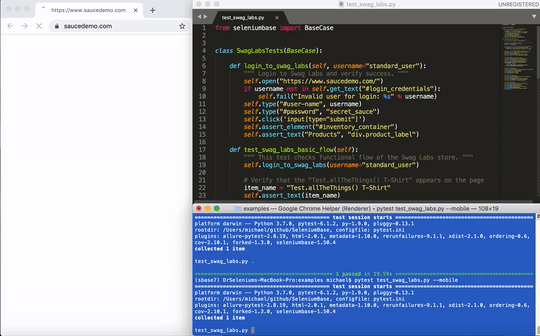3.2 KiB
3.2 KiB
 Mobile Mode / Mobile Testing
Mobile Mode / Mobile Testing
Use --mobile to run SeleniumBase tests using Chrome's mobile device emulator with default values for Device Metrics and User-Agent.
Here's an example mobile test:
SeleniumBase/examples/test_skype_site.py
pytest test_skype_site.py --mobile
To configure Device Metrics, use:
--metrics="CSS_Width,CSS_Height,Pixel_Ratio"
To configure the User-Agent, use:
--agent="USER-AGENT-STRING"
To find real values for Device Metrics, see:
To find real User-Agent strings, see:
Here's another example of a mobile test:
SeleniumBase/examples/test_swag_labs.py
pytest test_swag_labs.py --mobile
Here's an example of configuring mobile settings for that test:
# Run tests using Chrome's mobile device emulator (default settings)
pytest test_swag_labs.py --mobile
# Run mobile tests specifying CSS Width, CSS Height, and Pixel-Ratio
pytest test_swag_labs.py --mobile --metrics="360,640,2"
# Run mobile tests specifying the user agent
pytest test_swag_labs.py --mobile --agent="Mozilla/5.0 (Linux; Android 9; Pixel 3 XL)"
For some SeleniumBase Syntax Formats, you can also use mobile=True to run tests in Mobile Mode:
from seleniumbase import Driver
driver = Driver(mobile=True)
try:
driver.open("https://www.skype.com/en/get-skype/")
driver.assert_element('[aria-label="Microsoft"]')
driver.assert_text("Download Skype", "h1")
driver.highlight("div.appBannerContent")
driver.highlight("h1")
driver.assert_text("Skype for Mobile", "h2")
driver.highlight("h2")
driver.highlight("#get-skype-0")
driver.highlight_click("span[data-dropdown-icon]")
driver.highlight("#get-skype-0_android-download")
driver.highlight('[data-bi-id*="ios"]')
finally:
driver.quit()



